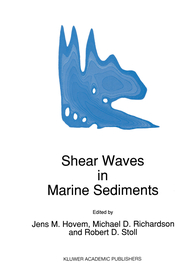-
Zusatztext
-
Shear waves and closely related interface waves (Rayleigh, Stoneley and Scholte) play an important role in many areas of engineering, geophysics and underwater acoustics. In some cases interest is focused on large-amplitude waves of low frequency such as those associ ated with earthquakes and nuclear explosions; in other cases low amplitude waves, which have often travelled great distances through the sediment, are of interest. Both low and high frequency shear and interface waves are often used for seafloor probing and sediment characterization. As a result of the wide spectrum of different interests, different disciplines have developed lines of research and a literature particularly suited to their own problems. For example water-column acousticians view the seafloor sediment as the lower boundary of their domain and are interested in shear and interface waves in the near bottom sediments mainly from the standpoint of how they influence absorption and reflection at this boundary. On the other hand, geophysicists seeking deep oil deposits are interested in the maximum penetration into the sediments and the tell-tale characteristics of the seismic waves that have encountered potential oil or gas bearing strata. In another area, geotechnical engineers use shear and interface waves to study soil properties necessary for the design and the siting of seafloor structures.
-
-
Kurztext
-
InhaltsangabeSection 1 Physical properties and laboratory measurements.- Shear waves in marine sediments-bridging the gap from theory to field applications (Opening paper).- Surface waves in poro-viscoelastic marine sediments.- An investigation of causality for Biot models by using Kramers-Krönig relations.- Soil properties for shear wave propagation (Invited).- The relevance of shear waves for structural subsurface investigations.- Experimental investigation of seismic surface waves in the seafloor.- Laboratory studies on pulsed leaky Rayleigh wave components in a water layer over a solid bottom.- Assessment of shear strength of the sea bottom from shear wave velocity measurements on box cores and in-situ.- Numerical modelling and laboratory experiments on underwater sound propagation over a shear supporting bottom.- A review of laboratory shear wave techniques and attenuation measurements with particular reference to the resonant column (Invited).- Relationship between acoustic and mechanical properties of two marine clays.- A laboratory method to investigate shear waves in a soft soil consolidating under self weight.- Laboratory measurements of acoustic properties of periplatform carbonate sediments.- Comparison of measured compressional and shear wave velocity values with predictions from Biot theory.- Wave velocities in sediments.- Shear wave attenuation in unconsolidated laboratory sediments.- Shear wave velocities of glacio-marine sediments: Barents Sea.- Rock acoustics: relevance of the porous viscoelastic model.- Influence of stress state and stress history on acoustic wave propagation in sedimentary rocks.- Section 2 Field experiments and interpretation.- A summary of DREA observations of interface waves at the seabed.- Observations of the relative contributions of waterborne and sediment paths to the received acoustic signal.- Shear-wave anisotropy in marine sediments around Britain from surface sources.- Refraction measurement of shear wave anisotropy in shallow marine sediments and implications for reflection processing.- Spatial variability in ground motion: effects of material heterogeneity in seafloor sediments.- Implications of deep-water seismometer array measurements for Scholte wave propagation.- Shear wave velocity structure from interface waves at two deep water sites in the Pacific ocean.- The effects of shear velocity structure on seafloor noise.- Concurrent observations of directional spectra of ocean surface waves and microseisms from an ocean subbottom seismometer (OSS) array.- Wave propagation in a borehole (Invited).- Application of shear wave measurements in boreholes.- Experience with the seismic cone penetrometer in offshore site Investigations.- Comparison of techniques for shear wave velocity and attenuation measurements.- Shear wave velocity gradients in near-surface marine sediment.- ISSAMS: an in situ sediment acoustic measurement system.- Small-scale in situ measurements of S-H velocity in surficial sedimentary deposits: localised textural and biological controls.- In situ measurements of shear-wave velocity in ocean sediments.- Seafloor shear wave velocity data acquisition: procedures and pitfalls.- Mapping of the sea bed via in situ shear wave (SH) velocities.- Observations of split shear-waves from young ocean crust.- Estimation of shear-wave speed in ocean-bottom sediments by comparing oblique-angle reflectivity measurements with normal incidence data.- SedimentQpfrom spectral ratios of converted shear reflections.- Constraints on shear velocities in deep-ocean sediments as determined from deep-tow multichannel seismic data.- Changes inPandSvelocities caused by subduction related sediment accretion off Washington/Oregon.- Compressional and shear wave velocities in the upper crust.- Sedimentary shear modulus and shear speed profiles from a gravity wave inversion.- Measurements of compressional wave and shear wave speeds, attenuation, permeability, and porosity in marine sediments.- Sea-bed shear mod
-
Detailansicht
Shear Waves in Marine Sediments
ISBN/EAN: 9780792313571
Umbreit-Nr.: 6760420
Sprache:
Englisch
Umfang: xv, 593 S.
Format in cm:
Einband:
gebundenes Buch
Erschienen am 31.07.1991
Auflage: 1/1991


